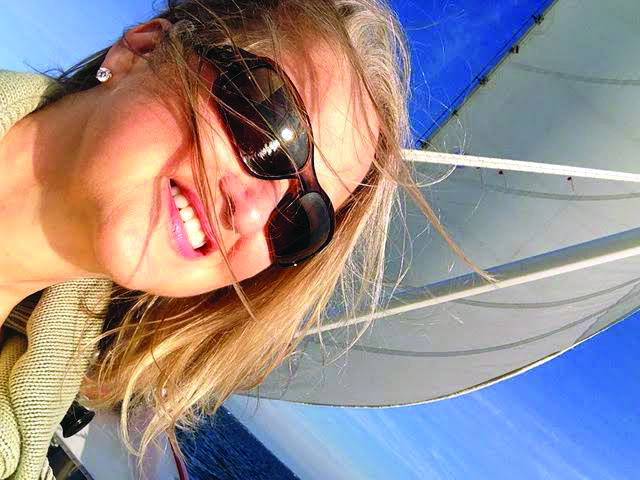The night before I started a week-long sailing course I learned that my not-so-recent-former boyfriend had gotten married. I was stunned. He was the one who introduced me to sailing; he was the one who convinced me to move to Annapolis. What was originally our dream of cruising the Chesapeake Bay and spending winters in the British Virgin Islands was now mine to discover alone.
Monday morning I walked to class staring at the ground, my thoughts stuck in the past repeating his promises of “life on the water” while sipping wine on the bow. My desire to be a sailor had vanished overnight.
The first thing I learned about sailing was that sails have one of two responses to the wind: push or pull. Hmm… that sounded familiar: I had just lived through something like that. The instructor drew diagrams on a white board while I drew little boats on my notepad with blue arrows to depict the wind. He was speaking a whole new language—tacking, trimming, clew, cleat—and it wasn’t sinking in. My mind was somewhere else.
Preparing the boat, I soon learned every maneuver had a name, every line a purpose, every inch on deck a role. Tuesday it rained five inches. Wednesday, the wind died, and we sat in full sun tying knots. There was no head, no motor, and one day, a broken tiller. Down to only two students by Thursday, my co-crew and I doubled up as our instructor barked “TACK” in five-minute intervals. My knees were bloody, my arms bruised, my face red except for a horizontal line of white between my eyes and ears.
I won’t say I loved it. In fact, I wanted to quit. But I gutted it out and by week’s end hoisted a certificate that’s now framed and hanging on my wall. More importantly, the physical exertion and cramp in my neck from looking up at telltales took my mind off of… ahhh… whatshisname.
At the end of the week, not only was I still feeling a gentle rock when I lay down at night, but I also realized that sailing had taught me some things about love I had struggled to learn on land.
Competing forces are always at play. Nothing about sailing is constant. If it’s not a dull wind, it’s changing currents or rising tides. Any combination of challenges can surface, and a solution that worked one day may be of no use the next. Relationships are no different. Things such as job loss, chronic illness, and money problems all stress relationships, even the best of them. Looking back, I see how hard my “ex” and I had worked to find common ground, but the differences we brought to the relationship—in the beginning alluring and fun—resurfaced over time and made it difficult to adjust.
Teamwork is essential; there’s only one skipper at a time. Each crew member has a role on a sailboat, and working as a team is essential. No one gets to go rogue. There’s only one skipper, even if several rotate at the helm. Crew don’t question this even if their advice is sought or collectively everyone weighs in on how to avoid running aground. Similarly, relationships require teamwork and supporting the other when you disagree. Having been single most of my life, I see now how difficult it was for me to do this. Too often we worked against each other instead of together. Looking back, I realize neither of us wanted to crew.
Bumps and bruises are to be expected; bring First-Aid. If I had known beforehand how physically demanding a week-long sailing course would be, I would have opted for a massage at the spa. At night I stepped out of my wet clothes and collapsed on the bed with sticky skin and achy joints. Falling in love can create its own discomfort, so knowing what soothes the sore goes a long way in building harmony: meditation, exercise, humor, and time alone. Developing a tough skin helps, too. Learning to go with the flow, even better.
Know where you’re headed; agree to get there together. Most of the time in sailing school we were sailing around in circles, back tracking on bubbles, learning to do figure eights. We didn’t have a destination in mind. Relationships can be the same way. That’s fine if both parties agree that a deeper commitment isn’t what they want. But if you do, find the next point on the map, and commit to doing everything you can to get there together. As with sailing, relationships run much more smoothly when there’s an agreed upon point of sail.
Know how to anchor; recognize when you’re not. Just as in sailing, anchors are essential to good relationships. Traditions, customs, political views—all strengthen the bond between two people in a way the outside world cannot. My ex and I had completely different backgrounds. While it made for an intriguing and steamy start, over time what had brought us together didn’t keep us together. We drifted apart.
When tilting over, don’t lean in. The first time I was heeling with the other side of the boat barely visible over the tips of my pink plaid Sperrys I thought I would fall head-first into the water. It was both exhilarating and frightening. The next time, more fun than fear. But what I learned quickly about heeling is this: don’t lean in! Lean back even if it seems unnatural to do so. It’s the only way to keep your balance.
There’s no doubt I did just the opposite when the relationship was in full tilt. I over-analyzed, ruminated, cajoled, and opined at full throttle hoping to course correct. Sailing has shown me a better way: to lean back and reclaim my balance, and the boat will, too. Maybe if I had done something similar, the relationship would have survived. Hard to say. We never got back on course.
Learning to sail has shown me a new way of looking at relationships. Both require adapting to change and working as a team. If all goes well, most are full of sunny skies and gentle winds. I can’t wait to learn more… about sailing, that is.
--by Gwen Mayes






